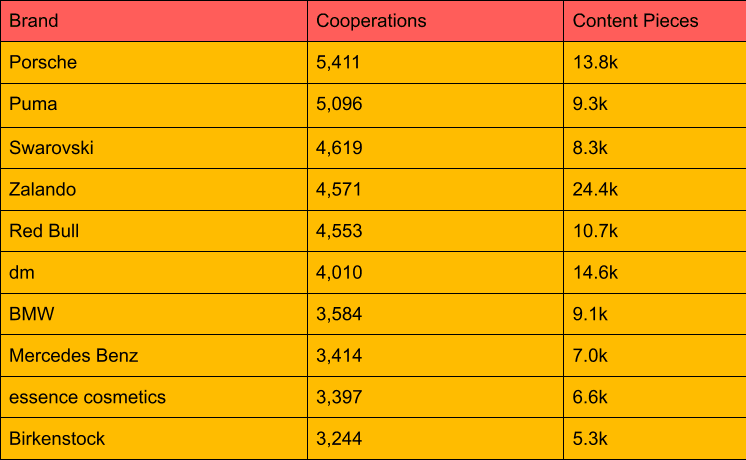
Reading time: 8 minutes
An influData analysis shows which brands from the DACH region have collaborated with the most influencers since 2024 and why it makes sense to work with more than just a few creators
The Essentials at a Glance
Working with a variety of influencers is beneficial for brands because different creators have very individual audiences. This allows for reaching a larger community and, accordingly, more potential customers. In addition, this approach increases reach, achieves top-of-mind awareness, and spreads risk. From early 2024 to October 2025, companies in the DACH region created almost 5 million pieces of content in 1.25 million collaborations with Instagram creators.
influData has analyzed collaborations between brands in Germany, Austria, and Switzerland and influencers on Instagram since 2024 and found that companies work with an average of 10 different advertising ambassadors. This resulted in an average of 17 pieces of content (posts, reels, or stories).
Obviously, the number of collaborations depends on the budget available to a company and whether or not a product is particularly suitable for the target group on social media. In general, however, influencer collaborations make sense for companies because they are an authentic and targeted form of marketing. In contrast to “anonymous,” i.e., scattergun advertising via TV, radio, or online banners, influencers build a particularly close, almost personal relationship with their community and often enjoy a high level of trust among their followers. When they recommend a product or incorporate it into their content, it subliminally appears much more credible than traditional advertising. In addition, such collaborations enable companies to increase their reach, address new target groups, and boost their brand awareness. Furthermore, the collaboration results in diverse, creative content that makes the brand appear modern and approachable.
But why does it make sense to work with different creators rather than having just one or a few brand ambassadors?
Since every influencer has their own unique audience, a large portfolio of creators can reach a larger community and, accordingly, more potential customers. And even if a certain number of influencers have the same following, this can be an advantage for brands, as in this case, a user learns about a product or service from several creators at once. This in turn increases trust, in line with the motto “slow and steady wins the race.” If users hear from a handful of people they trust that a product or service is recommended, this leads to increased awareness and a more positive image of the brand in question.
Furthermore, it makes sense to work with several influencers, as certain target groups are only active on certain social media platforms. While young people are mainly active on Snapchat and TikTok, the opposite is true for Facebook. Instagram has become the industry leader in the meantime, but platforms such as YouTube or Twitch may be better suited to reaching certain niches. Through numerous collaborations, a company can specifically address several target groups at the same time – or the same audience on different social networks.
The more influencer collaborations a brand has running at the same time, the more often the brand appears in users' feeds. This ensures top-of-mind awareness.
Last but not least, creator collaborations can also be thought of as a good investment portfolio. Not every collaboration will be successful (from the outset). From a risk diversification perspective, it therefore makes perfect sense for brands to spread the “burden” of the task across many shoulders.
On a side note, even with a small advertising budget, it makes more sense to use several small creators than to collaborate with a star influencer on a one-off basis, as the engagement rate and trust level is always higher with nano and micro influencers.
It therefore always makes sense to have several collaborations with creators running at the same time. However, there is no general answer as to where exactly the minimum or maximum lies - it depends entirely on the brand, its budget, and its goals.
Which brands from Germany, Austria, and Switzerland are currently working with the most influencers? influData took a look at this as well. From the beginning of 2024 to the beginning of October (January 1, 2024 - October 6, 2025), a total of over 33,000 brands in the DACH region collaborated with at least one influencer. This resulted in over 1.25 million influencer collaborations and almost 5 million pieces of content. Porsche is the frontrunner with 5,411 collaborations. Prozis Germany created the most pieces of content during the period under review, with over 25,000.
Sorted by number of cooperations:

Data source: influData